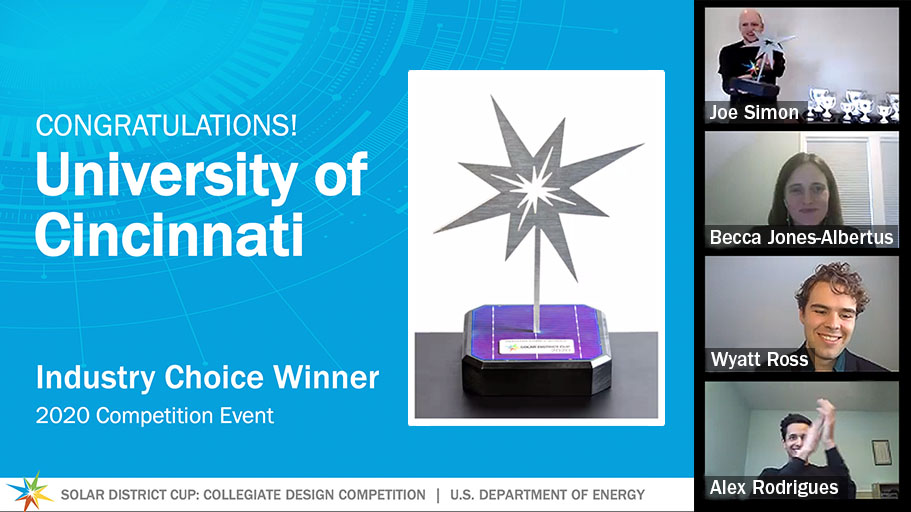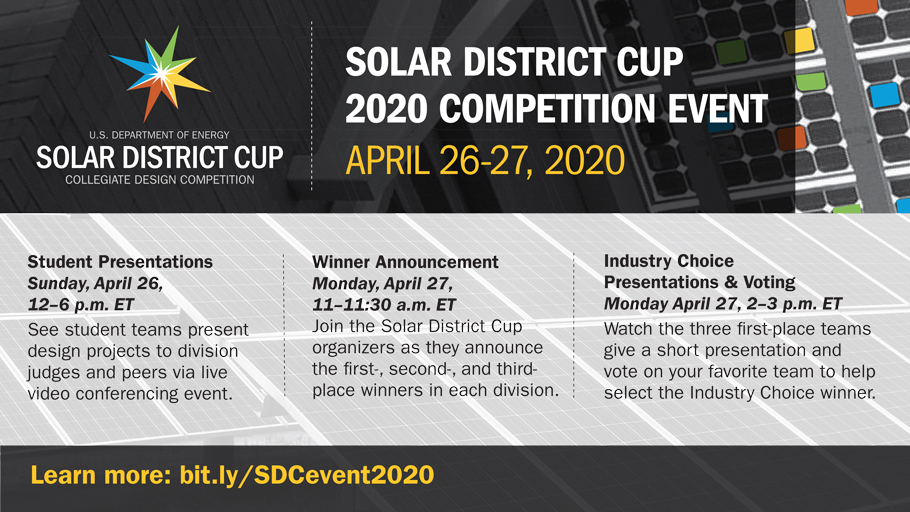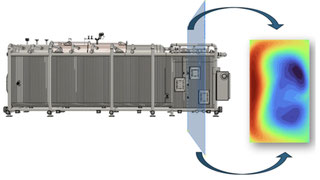The U.S. Department of Energy Solar District Cup Collegiate Design Competition is proud to have the enthusiastic support of industry professionals as judges for the 2020 competition event.
Judges for Division 1: Crystal Parks District Use Case
Keith Cronin
President, SunHedge LLC
Keith Cronin studied business administration before starting an energy startup in Hawaii in 1998. The company was acquired by SunEdison in 2007. Cronin started SunHedge in 2008, with a focus on project development, consulting, and distance learning.
Brion Fitzpatrick
Director of Business Development, Nexamp
Brion Fitzpatrick holds a Bachelor of Arts in marketing communications from Columbia College. He has a background as a commercial-, public-, institutional-, and utility-scale project developer for more than 60 projects in the U.S. Fitzpatrick is currently the director of Southeast business development at Nexamp, a national leader and owner of community solar, commercial and industrial, and greenfield development.
Jonathan Gritz
Director of Energy, JBG SMITH
Jonathan Gritz received a Bachelor of finance from Yeshiva University and a Master of Business Administration from Georgetown University. He manages the energy conservation programs for JBG SMITH, including the JBG SMITH Tenant Service Center, a 24/7/365 operations center that controls the heating, ventilation, and air conditioning (HVAC) systems across JBG SMITH’s portfolio. Gritz implements a broad range of energy programs across 20 million square feet of owned and managed buildings, including analytics and fault detection, optimized programming strategies, energy audits, and energy use reporting.
Dana Clare Redden
CEO, Solar Concierge
Dana Redden holds a Bachelor of Science from Drexel University, as well as an Executive Master of Business Administration from IE Business School and Brown University. In 2016, she founded Solar Stewards, a third-party solar program directly connecting corporate social responsibility initiatives with impact capital to develop solar on universities, affordable and senior housing, places of worship, and non-profits. Redden is currently the CEO of Solar Concierge, a consultancy dedicated to helping communities and businesses utilize solar, which she founded in 2012.
Aram Shumavon
CEO, Kevala, Inc.
Aram Shumavon is an economist by training with a Bachelor of Arts in public policy and economics from the University of Chicago. Previously, he provided advisory services to the California Public Utilities Commission and founded the advocacy organization Distributed Energy Consumer Advocates, a national nonprofit consumer-oriented energy policy organization. Shumavon is currently the CEO at Kevala, Inc., an energy and environmental data aggregation and analytics firm specializing in data analysis and mapping in the electricity sector.
Judges for Division 2: New Mexico State University District Use Case
Toyah Barigye
Senior Project Manager, The Solar Foundation
Toyah Barigye holds a Master of Science in sustainability management with a focus on renewable energy from Columbia University and a Bachelor of Science from the University of Connecticut. Prior to joining The Solar Foundation, she worked as a renewable energy specialist at Arcadia Power, recruiting solar and wind energy clients. She is now on both the technical assistance and designation teams of the SolSmart program and works with communities to reduce solar soft costs, lower barriers to solar energy, and streamline planning and zoning, permitting, and inspection processes aligned with industry best practices.
Pat Chavez
Director of Utilities and Plant Operations for Facilities and Services, New Mexico State University
Pat Chavez received his Associate of Applied Science in HVAC from New Mexico State University (NMSU). His previous career experience includes being a department supervisor at NMSU, a project engineer at an energy services company, a mechanical systems specialists at a satellite tracking station, and an energy manager at NMSU. Chavez’s current list of positions includes serving as director of utilities and plant operations at NMSU, an AEE-certified energy manager, certified building commissioning professional, and assistant professor at the Dona Ana Community College.
Michael Coddington
Principal Electrical Engineer, National Renewable Energy Laboratory (NREL)
Michael Coddington earned a Bachelor of Science in electrical engineering in addition to being a licensed electrical contractor and master electrician. He was formerly an electrical distribution planning engineer for Xcel Energy, focused on the City and County of Denver Division. Coddington now works at NREL on the development of distributed energy resources (DER) standards and codes; the state, national, and international DER interconnection procedures; providing support for the U.S. Agency for International Development; and the U.S. Department of Defense projects.
Christopher J. Lord
Managing Director, CapIron, Inc.
Christopher Lord holds a Juris Doctor degree from Cornell University School of Law and a Bachelor of Arts from Reed College. He has been general counsel of a publicly traded technology firm and energy finance firm, as well as counsel to energy development projects, utility financings, energy efficiency securitizations, and renewable energy transactions. Lord currently teaches online courses related to solar energy on HeatSpring and serves as managing director of CapIron, Inc., a firm he founded to provide advisory and consulting services to businesses, projects, utilities, development companies, and manufacturers in the green energy and environmental sustainability sectors.
Evan Riley
Founder and Partner, White Pine Renewables
Evan Riley holds a master’s in solar engineering from the European Solar Engineering School and a Bachelor of Physics and Mathematics from Indiana University at Bloomington. His previous experience includes overseeing development for Cypress Creek Renewables for five years and serving as an independent engineer for Black & Veatch for five years, where he worked on project- and corporate-level transactions. In his current role, Riley focuses on leading the clean energy transition through technological and business model innovation.
Judges for Division 3: Ball State University District Use Case
Bakary Coulibaly
Development Engineer, SolAmerica Energy
Bakary Coulibaly earned a Bachelor of Science in Electrical Engineering from the University of the District of Columbia. He specializes in early-stage project development and project engineering. Currently, he oversees the engineering aspects of project development for SolAmerica Energy and is working on a 15-megawatt portfolio in Illinois as part of the Adjustable Block Program from the Illinois Power Agency.
Kristen Fornes
Director of Business Development, ENGIE
Kristen Fornes received a Bachelor of Science in Finance from DePaul University and a Master of Business Administration in sustainable management from Kellstadt Graduate School of Business at DePaul University. She started her career selling retail power contracts to small business customers for AEP Retail Energy in Chicago. She is now responsible for developing distributed solar and storage projects for Fortune 1000 customers, cities, and universities for ENGIE, a multinational electric utility company.
Nick Heine
Engineer III, Electric Power Research Institute (EPRI)
Nick Heine received his Bachelor of Science and Master of Science in mechanical engineering from the University of New Mexico. During his time as a graduate research assistant, he used OpenDSS to model the impacts of distributed energy resources on the grid. In his current role with EPRI, he works closely with utilities from around the world to develop bespoke solutions for integrating and operating portfolios of distributed energy resources on electric power distribution circuits.
Robert J. Koester
Professor of Architecture, Ball State University
Robert Koester earned a Bachelor of Architecture from the University of Kentucky and a Master of Architecture from Rensselaer Polytechnic Institute. He is the founding and current director of Ball State University’s (BSU’s) Center for Energy Research/Education/Service, in addition to being a founding member of many other university councils, boards, and committees. Koester is currently a professor and director at BSU, serves as a chair member on the Council on the Environment, and is a university liaison for several environmental programs.
Sumit Ray
Director of Energy and Sustainability, University of Michigan—Dearborn Campus
Sumit Ray earned a Master of Science in industrial and systems engineering from the University of Florida and an Executive Master of Business Administration from Michigan State University. He has leadership experience in energy management, including central plants, combined heat and power, solar, wind, and sustainability business strategy development with knowledge of various emerging alternative energy and distributed generation technologies and applications. Ray is currently responsible for program development and serves on the President’s Commission on Carbon Neutrality initiative to reduce greenhouse gas emissions for the campus.











